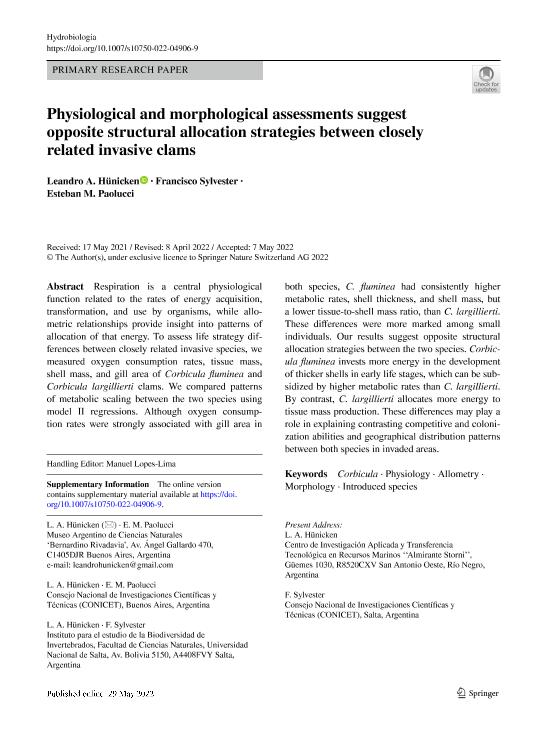Artículo
Physiological and morphological assessments suggest opposite structural allocation strategies between closely related invasive clams
Fecha de publicación:
07/2022
Editorial:
Springer
Revista:
Hydrobiologia
ISSN:
0018-8158
Idioma:
Inglés
Tipo de recurso:
Artículo publicado
Clasificación temática:
Resumen
Respiration is a central physiological function related to the rates of energy acquisition, transformation, and use by organisms, while allometric relationships provide insight into patterns of allocation of that energy. To assess life strategy differences between closely related invasive species, we measured oxygen consumption rates, tissue mass, shell mass, and gill area of Corbicula fluminea and Corbicula largillierti clams. We compared patterns of metabolic scaling between the two species using model II regressions. Although oxygen consumption rates were strongly associated with gill area in both species, C. fluminea had consistently higher metabolic rates, shell thickness, and shell mass, but a lower tissue-to-shell mass ratio, than C. largillierti. These differences were more marked among small individuals. Our results suggest opposite structural allocation strategies between the two species. Corbicula fluminea invests more energy in the development of thicker shells in early life stages, which can be subsidized by higher metabolic rates than C. largillierti. By contrast, C. largillierti allocates more energy to tissue mass production. These differences may play a role in explaining contrasting competitive and colonization abilities and geographical distribution patterns between both species in invaded areas.
Palabras clave:
ALLOMETRY
,
CORBICULA
,
INTRODUCED SPECIES
,
MORPHOLOGY
,
PHYSIOLOGY
Archivos asociados
Licencia
Identificadores
Colecciones
Articulos(CIMAS)
Articulos de CENTRO DE INVESTIGACION APLICADA Y TRANSFERENCIA TECNOLOGICA EN RECURSOS MARINOS "ALMIRANTE STORNI"
Articulos de CENTRO DE INVESTIGACION APLICADA Y TRANSFERENCIA TECNOLOGICA EN RECURSOS MARINOS "ALMIRANTE STORNI"
Articulos(MACNBR)
Articulos de MUSEO ARG.DE CS.NAT "BERNARDINO RIVADAVIA"
Articulos de MUSEO ARG.DE CS.NAT "BERNARDINO RIVADAVIA"
Citación
Hünicken, Leandro Andrés; Sylvester, Francisco; Paolucci, Esteban Marcelo; Physiological and morphological assessments suggest opposite structural allocation strategies between closely related invasive clams; Springer; Hydrobiologia; 849; 12; 7-2022; 2859-2875
Compartir
Altmétricas




